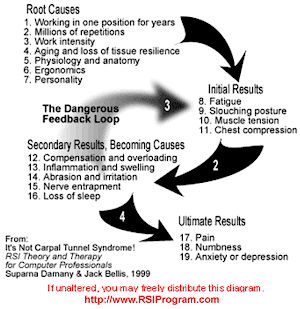Definition or TOS from Nicholas Institute:
"Thoracic outlet syndrome is a collection of syndromes brought about by abnormal compression of the neurovascular bundle by bony, ligamentous or muscular obstacles between the cervical spine and the lower border of the axilla."
My translation:
The shoulders and chest collapse over the top of the rib cage at spot where the nerves and blood vessels to the arms pass through a small opening.
There's a lot of debate, from the name itself (anatomists insist it's thoracic "inlet"!) to its involvement of nerves vs. circulation, but there's a lot of good info on the web. See list below. Here's an article that prefers emphasizing the tissue bundle that's affected, the brachial plexus.
As we explain in our 5-page theory, we believe that TOS---in computer users---is a whole cycle of factors starting with fatigue, then collapsed posture at the keyboard, which cuts off the circulation and or nerves at the chest and armpit, and feeds on itself to make your situation worse and worse. It doesn't help any that the medical world seems to ignore the big picture and focus only on the wrist when symptoms show up at the wrist and hands. I really try to stay away from bashing the practitioners, but countless sufferers repeat this scenario, so we've got to highlight this message.
Rarity/Hoax?
An article I saw recently showed five different configurations to the muscles at the thoracic inlet, what are called "anomolous" patterns. I wonder if this explains why some folks fall prey to TOS (and RSI in general???) and other don't. If my co-author's experience is any indication TOS is not rare at all. But that doesn't mean surgery to correct the thoracic outlet (risky at best) is called for. Most of the literature calls for exercise and resulting posture improvement. To detect TOS, there are a lot of tests but try this simple one: take a shower curtain off and on twice. If you can do it without serious aching I personally doubt you have TOS involvement.
As for whether it's a hoax of some sort, or used by insurance companies to manipulate patients, some of the companies are motivated by ignorance, fear, and/or greed, but there's no doubt about compression of the brachial plexus at the chest and armpit, folks. Here's a good article entitled "Fact or Fiction"
Cause or Effect?
Both, and that's bad news. In our diagram showing the cycle of RSI causes and effects, it might be the most insidious contributor to "The Dangerous Feedback Loop."
It's interesting to realize now, four years after the book and the diagram were created, that TOS isn't explicitly listed in the diagram. It's clear now that TOS includes all of the following causative numbers in the diagram: 1, 6, 8, 9, 11, 13, and 15.
So in summation, it's a big topic but not as controversial as carpal tunnel itself. Just plain old detective work and careful analysis of the whole RSI world seems to make TOS a huge suspect in many, many sufferers' scenarios.
